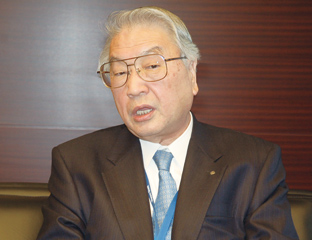
Mr. Shinichi Taniguchi, vice president of Nippon Steel, showed a vision the new integrated company between Nippon Steel and Sumitomo Metal Industries aims international A class rating early. He explained credit-rating agencies currently consider the integrated company’s classification should be lowered since the new company’s D/E (debt/equity) ratio would worsen to around 1.0 from Nippon Steel’s 0.8 despite of expected synergies for procurement, production, technology He suggested D/E ratio target is below 0.7 in order to regain A class rating and the new company should accelerate debt reduction under the trend of rising interest rates.
Mr. Taniguchi told the new company tries to increase cash flow by higher competitiveness while control cash out for strategic investments. He pointed out both Nippon Steel and Sumitomo Metals recently finished large capex for domestic iron works, which suggests the new company can compete with Chinese and South Koran steel makers by efficient utilization of renewed equipments. He indicated investing fund should be focused on technology development and overseas business expansion. Nippon Steel suspended no.2 blast furnace in Kimitsu iron works in December, ahead of the schedule. Mr. Taniguchi explained the relining would complete in mid May 2012 while the operative recommencement relies on the demand situation. He also referred to suspension of some of aged galvanizing lines by productive concentration into newest lines. He showed an expectation for higher productivity through the integration with Sumitomo Metals, involving utilization of low operating rate lines. Meanwhile, two joint companies between Nippon Steel and Sumitomo Metals, those which are Nippon Steel & Sumikin Coated Sheet Corp. and Nippon Steel & Sumikin Metal Products, currently accelerate business restructuring. Mr. Taniguchi said the two companies are trying to improve productivity and profitability while to enlarge global businesses through establishment of new production bases in Vietnam or China. As for the withdrawal from the bridge business, he explained the current business circumstance is even worsening than their plan. He overviewed current domestic steel market is very severe. He told Japanese automakers are hurrying to transfer their domestic operations to overseas while domestic shipbuilding volume is decreasing rapidly. He also viewed steel demand increase related to reconstructions in the disaster areas of the Japan Earthquake would become very temporary and limited. Thus Mr. Taniguchi suggested domestic steel demand might decrease more from current 600,000 tonnes per year. Meanwhile, he pointed out Japanese steel import is evidently increasing when Japanese manufactures are restructuring procurement and production processes for survivals. Mr. Taniguchi emphasized Nippon Steel tries to maximize outcome of its latest three-year management plan, adding extent six months until the integration in October 2012. He explained about realized measures such as fuel cost down and stable operation of blast furnaces, or better productivity and rolling speedup for steel sheet lines. He said Nippon Steel deepens discussions with Sumitomo Metals in order to seek new business chances by the management integration. Nippon Steel lately reviewed its full-year consolidated recurring profit forecast downward to 120 billion yen for fiscal 2011 ending in March 2012, 47% year-to-year minus. The initial forecast was 230 billion yen while lowered to 180 billion yen in October and to 120 billion yen in late January.











